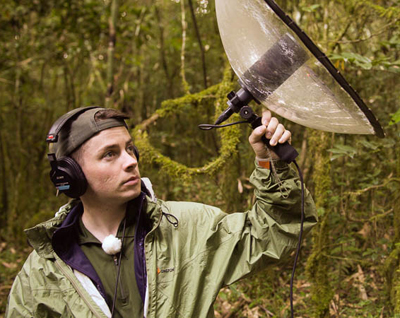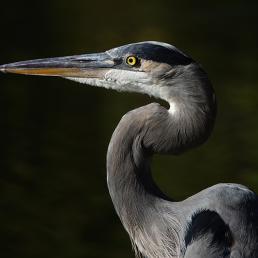

Join BirdNote tomorrow, November 30th!
Illustrator David Sibley and actor H. Jon Benjamin will face off in the bird illustration battle of the century during BirdNote's Year-end Celebration and Auction!
Tweets into beats:
We asked Wildlife DJ Ben Mirin to remix our theme song
Sound artist Ben Mirin travels the world collecting the sounds of nature. His energy is incredible. Ben, better known as DJ Ecotone, takes the sounds he finds and remixes them into frenetic, electronic compositions — he’s a wildlife DJ.

So when BirdNote realized we needed a new piece of music to introduce our new work, as we grow and adapt to tell new stories about birds and the environment, we called Ben.
Wow! We’re so glad we did!
DJ Ecotone’s playful “mash-up” of the BirdNote theme song features narrators Mary McCann and Michael Stein, Nancy Rumbel's original song composition, and many bird calls from the Cornell Lab of Ornithology.
We’re working to tune new audiences into birds — with podcasts, videos and feature stories, in addition to the daily BirdNote shows beloved by so many.
DJ Ecotone sat down to talk about sharing his passion for birds and science through music:
LISTEN TO THE EPISODE
Love our original theme music? We do, too! Think of this new theme song as a bonus: you'll still hear Nancy Rumbel's original classic jingle on our daily broadcast. Learn more about the creation of the original BirdNote theme song, composed and played by Nancy Rumbel and John Kessler.
Tell us what you think
We really do want to know! If you have feedback on this music, please email us. And thanks!
Full Transcript
[CLASSIC INTRO]
This is BirdNote.
The podcast. I’m MARY MCCANN.
Sound is special.
In public radio we’re partial to sound. We take it seriously.
At BirdNote, when you’re making a daily radio show, 365 days a year, you learn what works and why. You grow and adapt to tell the best stories you can, through our conversation with you.
But talking to people on the internet… it can be different.
JASON SAUL: I just got to BirdNote a few months ago, and they handed me this fascinating new project.
MARY MCCANN: That’s Jason Saul, BirdNote’s new managing producer.
JASON SAUL: We’ve been preparing to branch out into new ways of telling stories. Like this podcast. And we had commissioned this amazing new theme song.
JASON SAUL: Check it out. Just listen to how cool this is:
[FADE UP PLAY SONG]
JASON SAUL: I thought, I can’t wait to play this. Let’s make our whole first new podcast all about it. And then I thought, wait, who made this wonderful thing?
MARY MCCANN: It’s original music by Ben Mirin — better known as DJ Ecotone (pron: eee-ko-tone).
Ben is a sound artist, based in Brooklyn, who travels around the world gathering birdsong. Then he uses a DJ’s samplers and software to remix the recordings into new songs. He’s a wildlife DJ.
JASON SAUL: So, what kind of person becomes a wildlife DJ? What kind of history and intersectionality has to happen to produce such a wonderful musical idea? We gave Ben a call to find out.
JASON: Hi Ben, thanks for joining us today!
BEN MIRIN: It’s my pleasure.
JASON SAUL: When you’re asked to take a look at a musical idea and then think about what comes next, how do you start?
BEN MIRIN: My composition process is very subjective, because it always depends on the story. One of the things that inspires me as a composer is the niche hypothesis, which dictates that different voices in an ecosystem have evolved simultaneously to occupy their own separate niches in the acoustic space. And so together, they coexist. Nature is not a shouting contest. And so when you hear birds waking up in the morning, you’re tuning into a lot of different conversations that are happening simultaneously and in perfect harmony. Every music producer has to mix different elements of a song so that they occupy their own spaces as well. But if evolution has done my job, then I become a messenger for the perfectly tuned orchestras that are constantly singing in nature already.
JASON SAUL: What did you like best about composing this new song for BirdNote?
BEN MIRIN: Balancing the existing theme song with all the bird songs that I listened to was really joyful. And also challenging. The artistic reward was great, because I got to do what I do — listen to bird songs for hours and hours — and then write down all the moments that are musically captivating to me. But then I got to combine that with musical elements from a song that already is tried and true, and come up with something totally different.
JASON SAUL: When you’re composing, you’re just listening and listening to bird songs?
BEN MIRIN: That’s a part of my process, is just sitting down and combing through vast collections of sounds, so I like to spend a long time listening to natural sound recordings, and sometimes incorporate them in an untouched fashion into the music. And so many of these bird songs aren’t just untuned, unpitched — they are not even cut. I just let them play. There are some tracks, like of the Barred Owl and the Potoo, that don’t have any tweaks. That is the key, that is the rhythm, that is the nature of those songs. And that’s just an incredible thing to me. I mean, when I added the Barred Owl at the end, and it was in the key of everything else, I just stood up and said, “That’s it! This is done. That was perfect.” And it wasn’t my doing. I just heard the Barred Owl. It was a gorgeous recording, and it fit perfectly. It rounded everything out. The sounds of crickets and the water in the background. I mean, you can’t ask for a better orchestra than that.
JASON SAUL: You’re working in what some people refer to as the “mashup culture.” Cheap digital tools give us the ability to mix and remix our own voices — and essentially everything that’s ever been recorded. As an artist, is that something that’s liberating? Or can it be hard to know where your boundaries are?
BEN MIRIN: As an artist I think you’re always redefining your boundaries. Part of the learning process comes from going outside of your comfort zone and that means trying things that you’ve never even made before. Working within the sample culture, the hip hop culture that has inspired me about living here in New York, you do pick up on a lot of different traditions of how to create your art. So, hip hop has a certain mentality of taking different elements and mixing them together to create a new idea. But that really is so much of what any kind of musical genre is.
And now of course as a wildlife DJ, I listen to the sounds of nature and my musical ideas come directly from wildlife. That’s one of the things that’s most rewarding about tuning in to nature, is that you can hear music in an unedited, unaffected bird song. There is an innate musicality and rhythm, and there’s even a key in there. And if you listen close enough, you can actually start to build an acoustic picture of the different sounds that would happen in any one environment.
JASON SAUL: How did you grow into this concept of a wildlife DJ?
BEN MIRIN: So I had a job here in New York City, and I left it towards the end of 2014. And I thought about maybe applying for some other jobs, going back to another office… but I’ll be honest, I’m not an office person at all.
JASON SAUL: Yeah, me either.
[Laughter]
BEN MIRIN: I’m just not cut out for that situation. I sat down at my computer and said to myself, “You know, I feel like I have been ignoring the naturalist side of myself. I’m living here in Brooklyn. I don’t feel like I have enough birds in my life. It’s admittedly extremely difficult to hear birdsong over the traffic outside my window. So there’s something that needs to be done about this. So I actually went online and started researching, and found a few bird calls that I had purchased and downloaded. And I sampled them. I focused on bird songs from New York City. And I started beat-boxing alongside these vocal samples. So I had a digital sampler in front of me, that I could play kind of like a piano, and while I played the bird songs, I just went:
[Beat-box sounds]
BEN MIRIN: And that was an innocent experiment. I put it on YouTube and shared it with some friends. And the amount of support I received from people I knew, and from people I had never met before, was unbelievable. I think because I was being honest. I was being myself. There is an inherent reward for yourself and your personal growth, if you just give in to what you love. Because it makes you then suddenly part of something bigger than just yourself. That’s been the greatest reward of codifying this identity as a wildlife DJ, is that I am working in conservation, and I am working in science. I’m becoming an explorer. I’m learning from true scientists, and from people who have done some incredible things to advance our understanding of the world. All by combining things that I love.
JASON SAUL: [Laughs] Wow, that is incredible. What a fun thing to do all day. So, I’ve never talked to a real-deal beatboxer before — can you explain more about it?
BEN MIRIN: Well. it’s easier said than done, I suppose, but beat-boxing is a combination of different vocal sounds that come together to create a musical idea. And, most simply put, it goes something like this:
[Beat-box sounds]
BEN MIRIN: Or you can change it up.
[Beat-box sounds]
BEN MIRIN: Or I can slow it down.
[Beat-boxin’]
BEN MIRIN: So, all those different sounds are made using my voice. I’m using my lips, my tongue, my cheeks… Every dimension of my vocal anatomy. So a beat-boxer is somebody who has an instrument with them at all times. And arguably that makes everyone a beat-boxer. But it’s also about embracing your inner noisy self and letting it out occasionally.
JASON SAUL: I gotta tell you right now, I want to let my inner noisy self out. Tell me, when you’re composing, are you using bird songs to create music? Or using music to tell the stories of birds?
BEN MIRIN: Am I using bird song to create music, or am I using music to tell the story of bird song? That’s a great question. I guess I’ve done a lot of different art throughout my life. I used to paint and draw; I have done photography. I now consider sound recording to be its own art form, because you’re working in a studio that does not follow any of humanity’s rules. And that’s kind of a beautiful thing. So you really have to surrender yourself to the environment and work within it, and take what it gives you. And be patient. So I would probably say that I am a musician trying to tell the story of the natural world. Because that is where I found my own voice and my own identity. Using music as a gateway to nature brought me into this new place, where I felt like I could really be myself and that I had stories that I really wanted to tell.
JASON SAUL: Our original theme was composed by Nancy Rumbel and arranged by John Kessler. Ben, I’m so glad you were able to reimagine this song.
BEN MIRIN: I’m just happy to have worked with Nancy and with John and with the whole team to create a musical narrative that celebrates both what BirdNote has done and what it will do. It really depends on what stories we want to tell together, and that’s the exciting thing. There’s no telling what kind of stories sound is going to turn up. But hey, we have not been listening as well as we could for a long time, and now we are really starting to tune in to nature. There is so much that we still need to explore through sound, and I’m excited to see what BirdNote does, and I’m excited to see what I get to do.
JASON SAUL: That’s really great. Ben Mirin. DJ Ecotone. Thank you so much for spending some time with us.
BEN MIRIN: It was my pleasure.
MARY MCCANN: Thanks again to DJ ECOTONE.
Ben’s been doing a lot of work with National Geographic, the Safina Center, and the Cornell Lab of Ornithology. Follow his expeditions on his website: Ben Mirin Dot Com - That’s M-I-R-I-N, or on Twitter, At Ben Mirin.
BirdNote is a small, independent public media show — based in Seattle, but in conversation with communities across the nation, and the world. Learn more about our team, and how you can help birds, at BirdNote Dot Org.
BirdNote’s technical director and producer is John Kessler. Ellen Blackstone is our associate producer. Kate Godman is our development director, and Liza Gonzales-Ramos is development and administrative associate. We had digital production help from Katie Meyer. Our managing producer is Jason Saul. And BirdNote’s executive director is Sallie Bodie.
Subscribe to BirdNote on iTunes, find us on SoundCloud and your local public radio station -- or tune in wherever fine nature podcasts are found.
Longer stories are a new thing for BirdNote -- tell us what you think on our website or on Twitter or Facebook. Until next time.... I'm MARY MCCANN.
###
This story was produced with support from the Bobolink Foundation.

